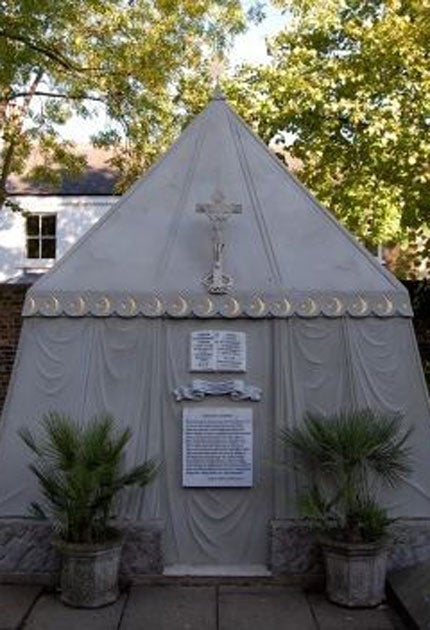The eccentric architecture of death
The restoration of Sir Richard Burton’s tomb may be a relatively small event – but it’s a very important one, says Jay Merrick

The architecture of death throws up extraordinary contrasts of form and effect. Exquisitely romantic homage in the case of the Taj Mahal; the remains of an ancient strip-mall of tombs along the Via Appia Antica as it approaches Rome; and, in Turkey, the big daddy – or perhaps big deady – of them all: the Mausoleum at Halicarnassus, one of the seven wonders of the world before it was reduced to rubble by earthquakes.
But in the churchyard of St Mary Magdalen's Church in Mortlake, London, the eye jumps to something of an entirely different order: the newly restored, tent-shaped mausoleum of Sir Richard Burton, the Victorian explorer most famous for publishing unexpurgated versions of The Kama Sutra, The Perfumed Garden and The Book of the Thousand Nights and a Night. As the blue and red carriages of the Waterloo train gargle through Mortlake station, Burton's tent might as well have a neon sign on it, proclaiming its Magritte-like surreality: Ceci n'est pas une tente.
The mausoleum, which measures 12ft by 15ft across its base, is not great architecture. But its stark eccentricity is of great importance: this high Victorian kitsch is precisely the kind of wilfully individual building that helps to give our cultural fabric its uniquely kinked texture. The Grade II* listed structure has just been repaired and renovated by HOK architects in a scheme set up by The Friends of Burton and the Environment Trust for Richmond upon Thames, funded by English Heritage and the Heritage of London Trust.
There's something comforting about finding such a remarkable building in unremarkable surroundings, next to an architecturally modest church, and within sight of the plain back walls of a terrace of 19th-century houses. The ordinary harbours the extraordinary – if not the ghosts of those who caught the 10am train from Waterloo on 15 June 1891 to join the throng of 400 mourners who attended Burton's funeral.
"Conservation projects are not just about the buildings, but the people behind them and the stories associated with them," says Mark Cannata, head of HOK's heritage and culture team. "It's this narrative quality that really excites us and makes these projects special. Even small, architecturally unexpected buildings like Burton's mausoleum can be extraordinarily resonant because they remind us, simultaneously, of the finite nature of life and the infinite possibilities of memory. These buildings are monuments in the truest sense of the word – they're the soul of architecture."
The mausoleum's design was conceived by Burton's wife, Isabel, in deference to her husband's wish that they "lie side by side" posthumously in a tent that would be a mystic mortuary-cum-caravanserai. The 5in-thick slabs of Forest of Dean sandstone that enclose them (his remains in a steel coffin, hers encased in mahogany) were carved to suggest a decorous riffling of canvas and guy-ropes in the sultry desert winds.
A rusted steel ladder, fixed in concrete two feet behind the back wall of the mausoleum, allows visitors to mount just high enough to gaze down through a thick glass panel in the sandstone roof. And there they are: the coffins, raised above the Carrara marble floor, the little altar, the darkly tarnished camel bells, second rate religious artwork, wreaths in glass domes, lanterns, vases, a bottle of holy water, candlesticks, a marble tabernacle, a statuette of the Virgin Mary.
The restoration of Burton's mausoleum is a timely reminder of the many unusual British buildings or settings that are barely surviving into the 21st century. More than 1,200 buildings and monuments remain on English Heritage's Buildings at Risk register.
Subscribe to Independent Premium to bookmark this article
Want to bookmark your favourite articles and stories to read or reference later? Start your Independent Premium subscription today.

Join our commenting forum
Join thought-provoking conversations, follow other Independent readers and see their replies